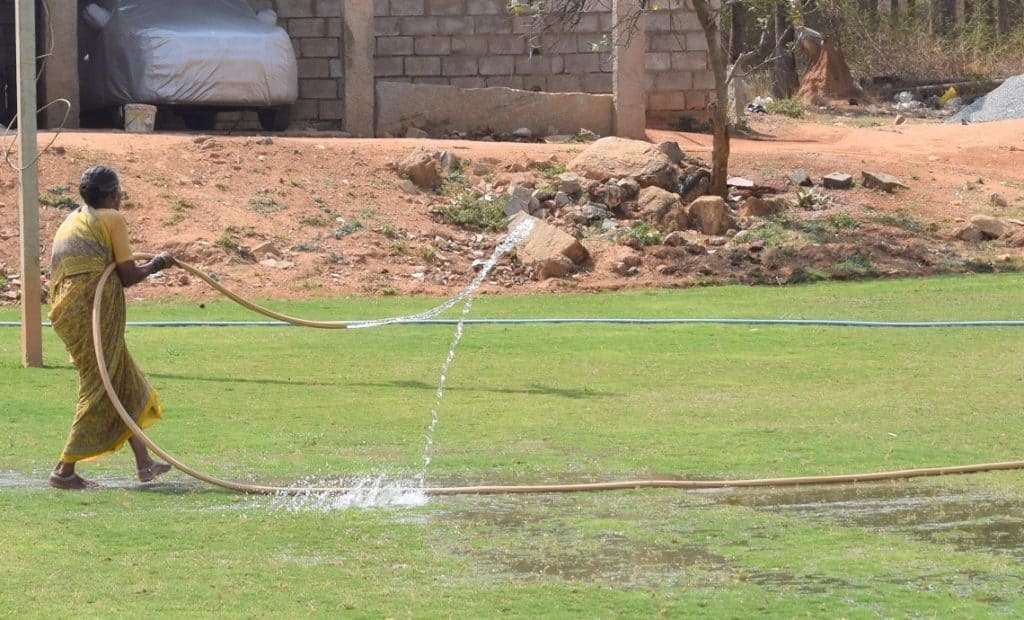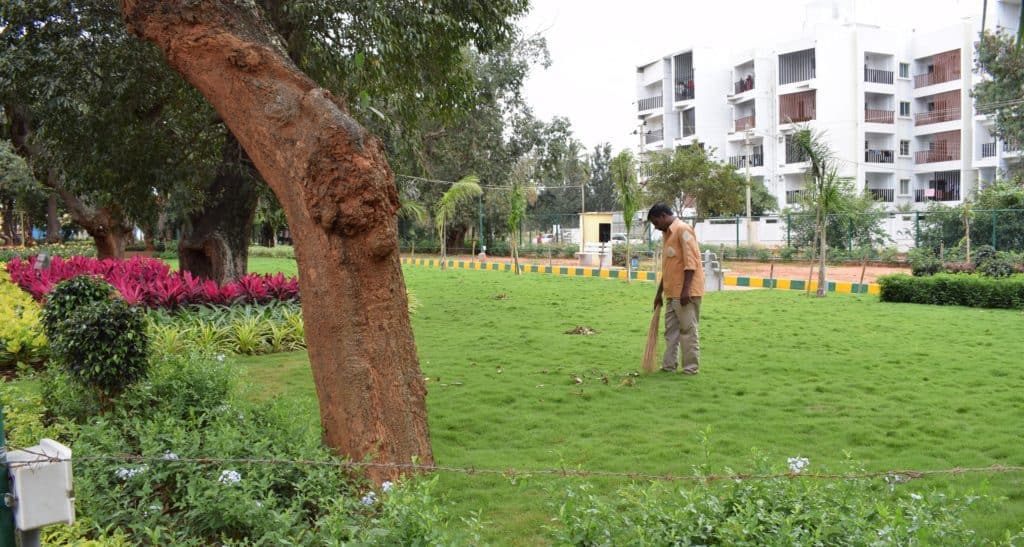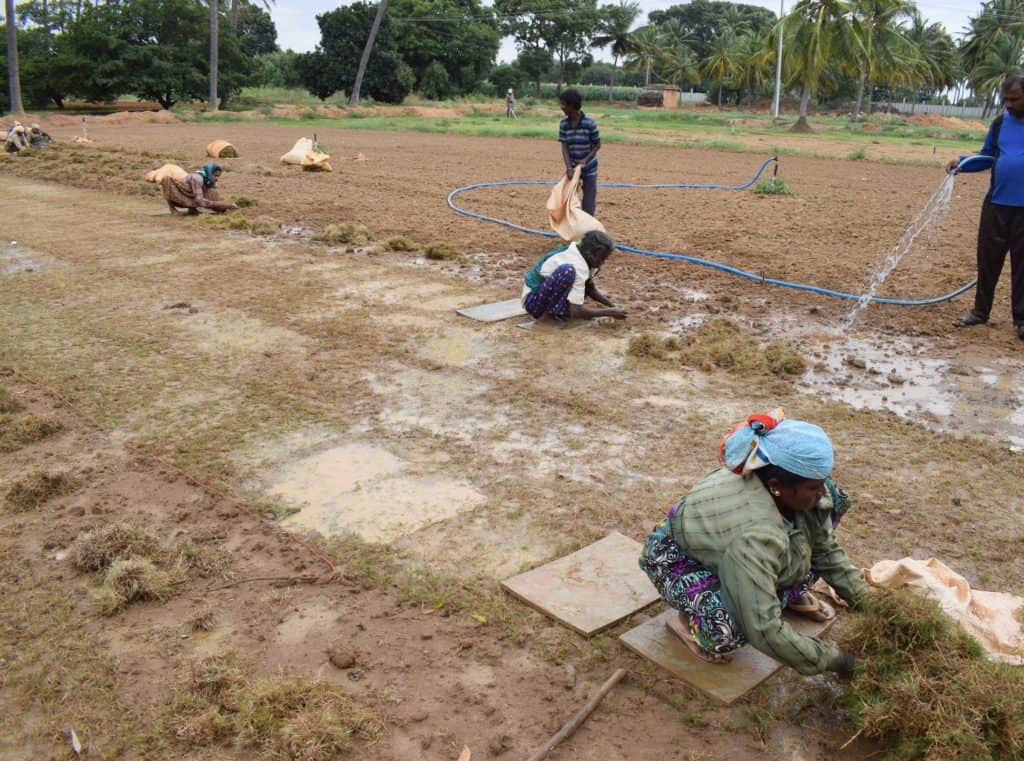Sprawling, manicured lawns in neighbourhood parks, golf clubs, hospitals, and the airport may seem like oases of greenery. But the fact that they are green deserts — negatively impacting soil fertility and displacing food crops such as finger millet, pulses, paddy — is often overlooked.
These are some of the findings in a 2018 study by Dr Seema Purushothaman, Sheetal Patil, Raghvendra Vanjari, A R Shwetha and Dhanya Bhaskar, from Azim Premji University, titled ‘The Other side of Development – Green Carpet or Green Desert?’. The study was conducted in the rural peripheries of North Bengaluru.
About why the study focused on North Bengaluru, Dr Seema, in an email interview with Citizen Matters, writes: “Some enquiries were conducted about hubs of lawn grass around Bengaluru, and we zeroed in on seven villages located in two taluks – Devanahalli and Doddballapura. South Bengaluru had more nurseries of ornamental plants.”
Reason for the study
“I have been studying the impact of urbanisation on agricultural landscapes and agrarian communities,” writes Dr Seema. “The city impacts them in many ways – it grabs land and water from agriculture, it fouls the water needed for agriculture, but it also generates demand for various agricultural produce. The latter should benefit a typical farmer to engage in agriculture with dignity. But we couldn’t say for sure if cities actually can sustain interest and livelihoods in farming. Thus I decided to take stock of the ways in which the city’s demand for farm produce was impacting the sustainability of farm livelihoods around it.”

There are food and non-food produce demanded by the city, from farms in its peripheries. Dr Seema observes: “Of the non-food demand, ornamental plants for landscaping were actually helping some enterprising farmers with resources to earn a livelihood. But it was displacing food crops and also was changing, or in fact reducing, the native agro-biodiversity. Lawn grass was a major demand from Bengaluru and other south Indian cities. Hence we decided to look at how turf grass cultivation is changing the fortunes of farmers who opt for it.”
Read more: Bengaluru’s lost crop varieties: How we are missing out on local, nutritious food
Lawn grass cultivation symbolises the city’s consumption culture. It requires capital, machinery, hired labour, lots of water and chemicals. “It takes away top soil and biodiversity,” says Dr Seema. “It may be of help to farmers waiting to leave agriculture, in earning the final bout of quick buck by exploiting the last bit of soil health. Often these farmers lack the capital needed and would have leased out land to a turf grass entrepreneur.”
How are lawns cultivated?
According to the study: “Lawns can be established by planting grass slips. But this takes time to establish and spread a green cover uniformly over the soil. There are different grass species requiring different levels of care and inputs to maintain uniform green cover throughout the year. Urban impatience, affluence, and indifference towards the impact of their actions on others and other landscapes, ensure demand for quick but extractive green carpeting. Thus, transplanting readymade mats of grass grown elsewhere is the norm followed in most lawns we see.”
The study goes on to state that farmers in the villages in Doddaballapura and Devanahalli taluks “grow Mexican lawn-grass extending to hundreds of acres.”
Maintaining turfgrass, the study notes, “demands garden labour for planting, manuring, weeding, edging scarifying, mowing and watering continually.”

Agricultural cost
The study points out that a lawn “often comes at the cost of fertile topsoil and water in agricultural lands”. Further, the lawn grass’ shallow roots “has displaced finger millet, pulses and even paddy from these farmlands, apart from clearing the land off bushes and trees. Village grazing lands are also often encroached for cultivating this grass. Unlike conventional crops grown, or newer plantations of eucalyptus and acacia, lawn grass requires high-intensity input use.”
The lawns are also sprayed with chemicals to protect plants and for more vegetative growth. Additionally, huge amounts are spent to pump out water lying deep beneath the ground. “Each farm has one or two borewells connected to sprinklers. This grass requires water every single day without fail, except during monsoons. Farmers also have to spend on equipment for pruning, weeding, spraying and harvesting,” the study notes.
Effect on biodiversity
If you look at lawns closely, you will observe an absence of grasshoppers, crickets, ants and other insects that are inhabitants of grasslands.
Read more: The secret life of solitary bees
Economic aspects
The average size of lawn farms range between five and 10 acres; though patches as small as half an acre are also used at times. As per the study: “The trend is to take land on lease from large holders at an annual rent of Rs 60,000 an acre, with borewell. Lease rate is Rs 40,000 for unirrigated land, where the lessee digs borewells and/or arranges to bring water from elsewhere.”
“Turfgrass farms require an initial investment of around Rs 1.5-2 lakhs an acre, including land lease charges if any, setting up irrigation facility, buying equipment, etc. On the whole, the cost of cultivating a square foot of lawn grass (including soil, inputs and labour) is about five rupees. Square or rectangle shaped grass sheets harvested with soil are sent to Bengaluru or to the neighbouring states of Kerala, Tamil Nadu and Andhra Pradesh, for Rs 10 to 12 per square foot. Buyers from the neighbouring states visit lawn farms and do on-the-spot purchases in large volumes.”

There is also the cost of supplementing soil from lake beds. The study observes that lawn grass harvested along with two inches of topsoil depletes the soil after about three to six harvests. As the soil begins to deplete, fresh soil, usually dug out from nearby lake beds is supplemented.
The soil from lake beds is supposed to be procured from the Gram Panchayat, at around Rs 500-1,000 per truckload. If silt from the lake bed is not available, turf farmers spend anywhere between Rs 2,500-6,000 per truckload of soil from excavated construction sites. An acre of turf grassland requires nearly two to 2.5 truckloads of soil to be supplemented every year.
Landscape architect Rekha Shankar says, “Most clients request green lawns as they are influenced by gardens they have seen in Europe or USA. Temperate climates are more conducive to turf than tropical climates. Sometimes it is a cheaper alternative to putting larger plants, but it comes at a heavy cost to the environment. Turf needs more maintenance in the long run as it requires a lot of water and chemicals to maintain it.”
Women farmers
A farmer receives nearly Rs 2 -3 lakhs an acre as net income, after every harvest, once in four months for lawn grass cultivation, says the study.

Labour from surrounding villages is employed for turfgrass cultivation. “Activities in these farms continue round-the-year, in cycles of 3-4 months’ duration.” Women are, in fact, employed in large numbers and lawn grass cultivation is their most lucrative and stable job as compared to other jobs. However, the study observes that the women workers face health hazards.
Field study
Raghvendra Vanjari writes of his experiences with field work. “Approaching farmers around metro cities like Bengaluru is really difficult. Having conversations about the context took enormous effort. When I wanted to talk about grass labour they said, ‘ask the owner, we don’t know anything’.”

Raghvendra says that many owners were not willing to talk much about their profits and ecological damages. “Women labourers are again tough to talk to, but once they get familiar with the field team they become the best respondents. In all the studied villages, I tried to get at least one woman farmer. During the first interaction they were reluctant to share any information, but as my visits were more frequent, they started narrating their untold stories. We acknowledge them sharing their views, experiences and information with us.”
Were some of the farmers concerned about the ecological impacts?
Raghvendra adds that farm labourers and landowners have expressed concern about:
- excessive use of chemical fertilisers and pesticides,
- tremendous amount of water use
- exhaustive removal of soil causing irreversible damage
“They are not much worried about common resources such as water bodies from where the soil is being taken for lawn grass cultivation, but are worried about losing the uppermost layer of soil from their own land,” says Raghvendra.
Conclusion
As to whether the study has been considered by any authority in policy making, Dr Seema says: “We haven’t done policy outreach. First reason is that our previous attempts at research informing policies directly were not successful. Second, there isn’t any one authority that can do something about a farmer’s crop choice. Thus we decided to popularise the findings in a video by sharing in our networks of Bengalureans and among peri urban farmers.” [Watch the video here.]